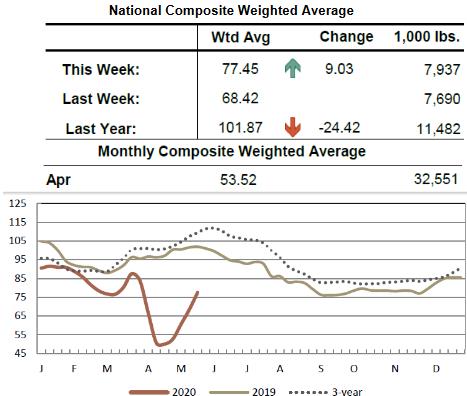 Weekly Broiler Production and Prices
Weekly Broiler Production and Prices
Chick Placements.
The Broiler Hatchery Report released on May 13th 2020 confirmed that a total of 228.3 million eggs were set during the week ending May 9th 2020, two percent lower than the corresponding week in 2019 and 3.2 percent more than the previous week. A total of 168.1 million day-old chicks were placed among the 19 major broiler-producing states during the week ending May 9th 2020. This was seven percent less than in the corresponding week in 2019 but 6.2 percent more than the previous week. Total chick placements for the U.S. amounted to 172.0 million, seven percent less than the corresponding week in 2019. Claimed average hatchability was 78.8 percent for eggs set three weeks earlier compared to 78.3 percent in the previous week. Cumulative placements for January 4th through May 9th 2002 amounted to 3.54 billion chicks, up less than one percent from the corresponding weeks in 2019.
 Broiler Production
Broiler Production
According to the May 15th 2020 USDA Broiler Market News Report (Vol. 67: No. 20) for the processing week ending May 9th 2020, 163.0 million broilers were processed during the past processing week (last week 162.0 million) at an average live weight of 6.37 lbs. (6.28 lbs. last week) and a nominal yield of 76.0 percent. The number of broilers processed was 0.9 percent less than the corresponding processing week in 2019. Processed (RTC) broiler production for the week was 788.9 million lbs. (358,588 metric tons), (773.3 million lbs. last week) 1.0 percent more than the corresponding processing week in 2019. For YTD 2020 Processed (RTC) production attained 14,952 million lbs. (6,796,324 metric tons), 4.6 percent more than YTD 2019.
Broiler Prices
The USDA National Composite Weighted Wholesale price on May 15th 2020 was up 9.0 cents per lb. from the previous week to 77.5 cents per lb. compared to 101.9 cents per lb. during the corresponding week of 2019; 53.5 cents per lb. for April 2020 and 109 cents per lb. for the three-year average. The USDA Composite price is rising after after a bottom during the last week of April at 52.7 cents per lb. The decline over the three previous consecutive weeks was attributed to the collapse of the food service segment following imposition of COVID-19 restrictions.
The USDA Southern States (SS) benchmark prices in cents per lb. (rounded to nearest cent) as documented in the Broiler Market News Reports May 815th 2020 are tabulated with a comparison with the previous week:-
|
Product
|
USDA SS1. Previous week
Cents/lb.
|
USDA SS1. Past week
Cents/lb.
|
Difference.
%
|
|
Whole Index
|
42
|
42
|
Unchanged
|
|
Tenderloins
|
127
|
140
|
+10.2
|
|
B/S Breast
|
124
|
145
|
+16.9
|
|
Whole Breasts
|
72
|
72
|
Unchanged
|
|
B/S Thighs
|
84
|
90
|
+7.1
|
|
Whole Thighs
|
35
|
35
|
Unchanged
|
|
Drumsticks
|
36
|
35
|
+2.8
|
|
Leg Quarters
|
32
|
34
|
+5.9
|
|
Wings (cut)
|
156
|
169
|
+8.3
|
- USDA Southern States prices
.
The USDA posted live-weight data for the past week ending May 11th 2020 and YTD 2020 were:-
|
Live Weight Range (lbs.)
|
<4.25
|
4.26-6.25
|
6.26-7.25
|
>7.76
|
|
Proportion past week 2018 (%)
|
19
|
33
|
25
|
23
|
|
Change from 2018 YTD (%)
|
+1
|
-10
|
+16
|
+10
|
During the past week broilers for QSR and food service (live, 3.6 lb. to 4.3 lb.) represented 19 percent (last week 21 percent) of processed volume.
On May 11th 2020 cold storage holdings at selected centers amounted to 95,688 lbs., 6.5 percent more than the inventory of 102,361 lbs. on May 1st 2019.
According to the most recent April 22nd 2020 USDA Cold Storage Report, issued monthly, stocks as of March 31st 2020 compared to March 31st 2019 showed differences with respect to the following categories:-
- Total Chicken category increased by 6.1 percent to 921.4 million lbs. (418,828 metric tons) on March 31st 2020 compared to 868.4 million lbs. (394,709 metric tons) on March 31st 2019
- Leg Quarters were up by 25.2 percent to 82.3 million lbs. consistent with the data on exports. Intended purchases by China were delayed by COVID-19 port disruptions. Imports by China, if they occur in volume, should reflect in the May Cold Storage Report. Unit revenue is documented in the Monthly Export Report under the STATISTICS Tab.
- The Breasts and Breast Meat category was up by 27.3 percent to 226.7 million lbs. despite increased domestic demand from retail.
- Wings showed a 12.9 percent increase, contributing to a stock of 53.6 million lbs.
Stock of this category will rise due to cancellation of college and professional sports seasons and events unless compensated for by exports.
- Paws and Feet increased by 26.7 percent to 33.9 million lbs. as a result of variable demand from Hong Kong and despite the entry of China, but at a progressively lower unit price. It will take until the second quarter to determine whether the Phase-One trade agreement and the end of the COVD-19 lockdown had any material effect on total export of feet.
- It is noted that the Other category comprising 389.8 million lbs. down 6.7 percent from March 31st 2019, represented a significant 42.3 percent of inventory on March 31st The high proportion in the Other category suggests further classification or re-allocation by USDA to the designated major categories.
*(See Poultry Meat Export Report under the STATISTICS Tab)
March 2020 Production
The USDA Poultry Slaughter Report released April 24th covering March 2020 comprising 21 working days recorded a total of 807.9 million head processed (up 2.6 percent from March 2019); Live weight of 5.11 billion lbs. (up 12.9 percent from March 2019); Unit weight of 6.33 lbs. (up 2.1 percent from March 2019). RTC attained 3.86 billion lbs. (up 12.9 percent from March 2019). The proportion marketed in March 2020 as chilled attained 92.8 percent. Post-mortem condemnations as a proportion of processed mass corresponded to 0.67 percent.
Comments
Placements of chicks and level of slaughter are assumed to be consistent with USDA projections.
The first cases of Newcastle disease in 2020 were diagnosed in San Bernardino County on January 8th and 13th. New cases were confirmed on February 18th, 21st and 25th, however the negligible incidence rate suggests that the outbreak is ending.
APHIS recorded 476 cases of velogenic viscerotropic Newcastle disease (vvND) in backyard flocks (predominantly “fighting cocks” and some maintained for table eggs) in the Counties of San Bernardino (164), Riverside (262), Los Angeles (46), Alameda (1), San Diego (1) and Ventura (1) from late-May 2018 to May 15th 2020. A single case of ND was diagnosed in a backyard flock (type and size not specified by CDFA near Redwood City in Alameda County during the week of March 27th 2019.There was no extension from this location.
Subscribers are referred to the report on a controlled outbreak of low pathogenicity H5N3 avian influenza in the Weekly Turkey report in this edition of CHICK-NEWS. Twelve asymptomatic turkey flocks in North and South Carolina were identified on surveillance. High pathogenic H5N3 was obtained from a single flock in South Carolina. All flocks were rapidly depleted and disposed of by composting on site.
Mexico has recognized the OIE principle of regionalization after intensive negotiations between SENASICA and U.S. counterparts in USDA-APHIS assisted by USAPEEC. Exports of broiler parts, fertile eggs and breeding stock should not be impeded unless there is extensive dissemination of vvND with involvement of the commercial poultry industry in central or northern California or adjoining states.
Provided importing nations adhere to OIE guidelines on regionalization, the limited cluster of apparently now eradicated outbreak of H7N3 low pathogenicity avian influenza in turkey flocks in the Carolinas should not materially affect exports.
CHICK-NEWS previously commented on the possible impact of failure to reconcile differences to achieve an equitable extension to the NAFTA agreement. The Senate of Mexico approved the Agreement on Wednesday 19th June 2019 and the U.S. Congress on January 16th 2020, followed by the legislature of Canada during the second week of March 2020.
During 2019 broiler exports to Mexico attained 683,018 metric tons. This represented 21.1 percent of export volume and 18.7 percent of export value (amounting to $605 million) of the export value of $3.23 billion. In the absence of the USMCA signed a year ago, tariffs on chicken could have risen to 75 percent of value creating a non-competitive situation favoring Brazil and Argentina. Sixth-ranked Canada imported 130,132 metric tons of broilers and parts during 2019 valued at $296.1 million. Collectively our NAFTA/USMCA neighbors imported broiler products to the value of $869 million during 2018 and $901 million in 2019.